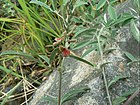Note: This is a project under development. The articles on this wiki are just being initiated and broadly incomplete. You can Help creating new pages.
Difference between revisions of "Indigofera oblongifolia"
(Created page with "{{stub}} ==Uses== {{Uses|}}, {{Uses|}}, {{Uses|}}, {{Uses|}}, {{Uses|}}, {{Uses|}}, {{Uses|}}, {{Uses|}}, {{Uses|}}, {{Uses|}}, {{Uses|}}.<ref name="Uses"/> ==Parts Used== {{...") |
(→Uses) |
||
| (3 intermediate revisions by the same user not shown) | |||
| Line 1: | Line 1: | ||
| − | + | [[File:Indigofera oblongifolia 1.jpg|thumb|right]] | |
| + | '''Indigofera oblongifolia''' is an erect perennial plant with many branched stems that become more or less woody, especially near the base, and persist. The plant is harvested from the wild for local use as a medicine and a dye. It is occasionally cultivated, as a living fence in Sudan. | ||
==Uses== | ==Uses== | ||
| − | {{Uses|}}, {{Uses|}}, {{Uses| | + | {{Uses|Skin rash}}, {{Uses|Stomach pain}}, {{Uses|Mercurial salivation}}.<ref name="Uses"/> |
==Parts Used== | ==Parts Used== | ||
| − | {{Parts Used| | + | {{Parts Used|Leaves}}. |
==Chemical Composition== | ==Chemical Composition== | ||
| Line 16: | Line 17: | ||
===Dravya=== | ===Dravya=== | ||
===Rasa=== | ===Rasa=== | ||
| − | |||
===Guna=== | ===Guna=== | ||
| Line 29: | Line 29: | ||
==Habit== | ==Habit== | ||
| − | {{Habit|}} | + | {{Habit|Shrub}} |
==Identification== | ==Identification== | ||
| Line 48: | Line 48: | ||
==Mode of Propagation== | ==Mode of Propagation== | ||
| − | {{Propagation|}} | + | {{Propagation|Seeds}} |
==How to plant/cultivate== | ==How to plant/cultivate== | ||
| Line 54: | Line 54: | ||
==Commonly seen growing in areas== | ==Commonly seen growing in areas== | ||
| − | {{Commonly seen|}}, {{Commonly seen|}}, {{Commonly seen|}}, {{Commonly seen|}}, {{Commonly seen|}}. | + | {{Commonly seen|Found especially near the coast}}, {{Commonly seen|Growing on edges of brackish places}}, {{Commonly seen|Streamsides}}, {{Commonly seen|Grassland}}, {{Commonly seen|Bushland}}. |
==Photo Gallery== | ==Photo Gallery== | ||
<gallery class="left" caption="" widths="140px" heights="140px"> | <gallery class="left" caption="" widths="140px" heights="140px"> | ||
| − | + | Indigofera oblongifolia 1.jpg | |
| + | Indigofera oblongifolia 2.jpg | ||
| + | Indigofera oblongifolia.jpg | ||
| + | LEG.-PAPIL., INDIGOFERA OBLONGIFOLIA, Diégo, Lucile 109.jpg | ||
</gallery> | </gallery> | ||
| Line 64: | Line 67: | ||
<references> | <references> | ||
| − | <ref name="chemical composition">[ | + | <ref name="chemical composition">[Chemistry]</ref> |
| − | <ref name="Leaf">[ | + | <ref name="Leaf">[Morphology]</ref> |
| − | <ref name="How to plant/cultivate">[ | + | <ref name="How to plant/cultivate">[Found on a variety of soils in the wild from black clays to sands Cultivation]</ref> |
<ref name="Uses">Indian Medicinal Plants by C.P.Khare</ref> | <ref name="Uses">Indian Medicinal Plants by C.P.Khare</ref> | ||
</references> | </references> | ||
==External Links== | ==External Links== | ||
| − | * [ ] | + | * [https:///species/shindiabiodiversity.orgow/279391 Indigofera oblongifolia on indiabiodiversity.org] |
| − | * [ ] | + | * [http://www.efloraofgandhinagar.in/shrub/indigofera-oblongifolia Indigofera oblongifolia on efloraofgandhinagar.in] |
| − | + | ||
[[Category:Herbs]] | [[Category:Herbs]] | ||
| + | [[Category:Pages without herbs images]] | ||
Latest revision as of 18:35, 19 May 2020
Indigofera oblongifolia is an erect perennial plant with many branched stems that become more or less woody, especially near the base, and persist. The plant is harvested from the wild for local use as a medicine and a dye. It is occasionally cultivated, as a living fence in Sudan.
Contents
- 1 Uses
- 2 Parts Used
- 3 Chemical Composition
- 4 Common names
- 5 Properties
- 6 Habit
- 7 Identification
- 8 List of Ayurvedic medicine in which the herb is used
- 9 Where to get the saplings
- 10 Mode of Propagation
- 11 How to plant/cultivate
- 12 Commonly seen growing in areas
- 13 Photo Gallery
- 14 References
- 15 External Links
Uses
Skin rash, Stomach pain, Mercurial salivation.[1]
Parts Used
Chemical Composition
Common names
| Language | Common name |
|---|---|
| Kannada | |
| Hindi | |
| Malayalam | |
| Tamil | |
| Telugu | |
| Marathi | |
| Gujarathi | |
| Punjabi | |
| Kashmiri | |
| Sanskrit | |
| English |
Properties
Reference: Dravya - Substance, Rasa - Taste, Guna - Qualities, Veerya - Potency, Vipaka - Post-digesion effect, Karma - Pharmacological activity, Prabhava - Therepeutics.
Dravya
Rasa
Guna
Veerya
Vipaka
Karma
Prabhava
Habit
Identification
Leaf
| Kind | Shape | Feature |
|---|---|---|
Flower
| Type | Size | Color and composition | Stamen | More information |
|---|---|---|---|---|
| {{{5}}} |
Fruit
| Type | Size | Mass | Appearance | Seeds | More information |
|---|---|---|---|---|---|
Other features
List of Ayurvedic medicine in which the herb is used
Where to get the saplings
Mode of Propagation
How to plant/cultivate
Commonly seen growing in areas
Found especially near the coast, Growing on edges of brackish places, Streamsides, Grassland, Bushland.
Photo Gallery
References
External Links
- Ayurvedic Herbs known to be helpful to treat Skin rash
- Ayurvedic Herbs known to be helpful to treat Stomach pain
- Ayurvedic Herbs known to be helpful to treat Mercurial salivation
- Herbs with Leaves used in medicine
- Habit - Shrub
- Index of Plants which can be propagated by Seeds
- Herbs that are commonly seen in the region of Found especially near the coast
- Herbs that are commonly seen in the region of Growing on edges of brackish places
- Herbs that are commonly seen in the region of Streamsides
- Herbs that are commonly seen in the region of Grassland
- Herbs that are commonly seen in the region of Bushland
- Herbs
- Pages without herbs images




